Fiona Outdoors Goes Electric In The Highlands
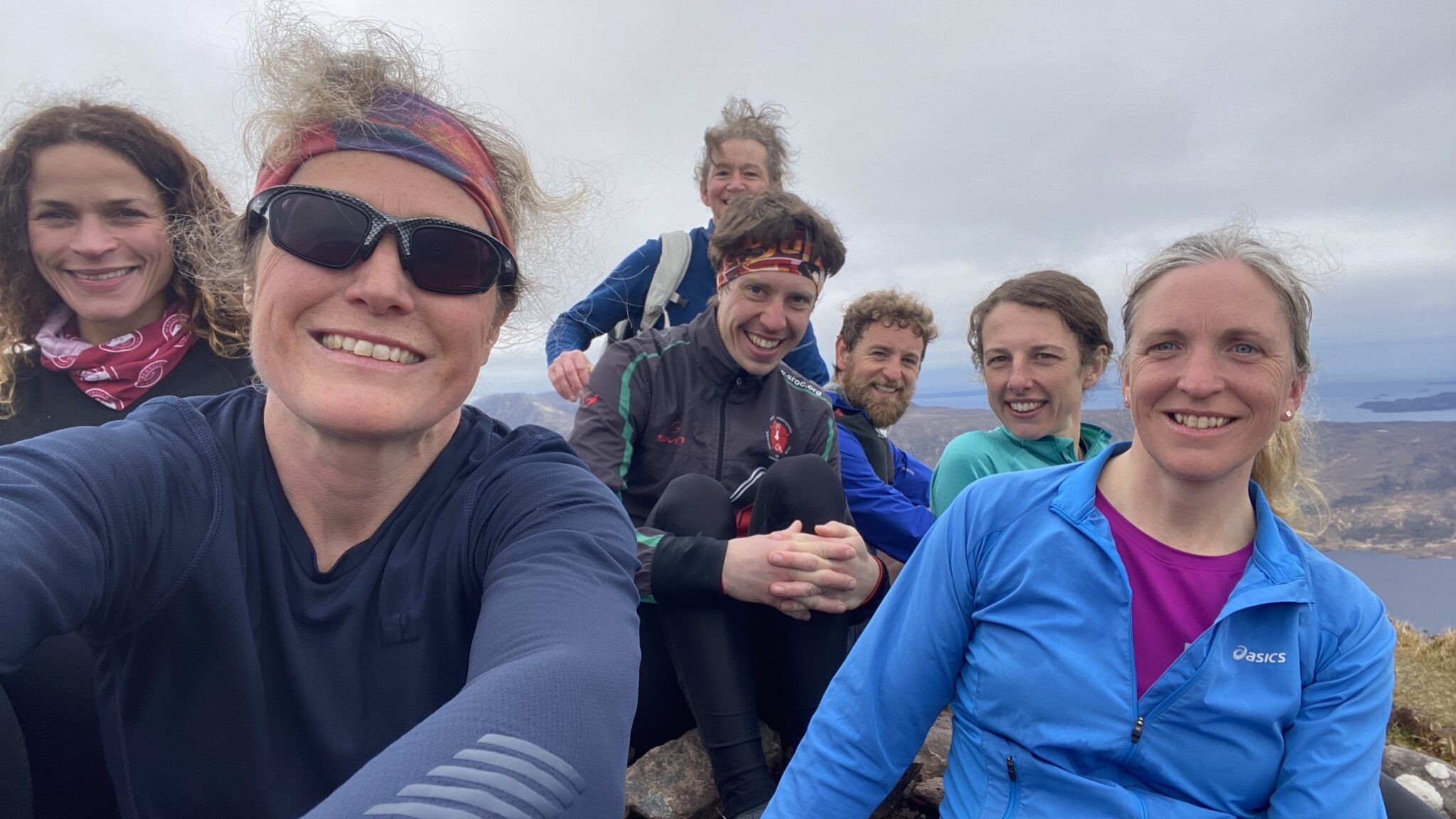
Let’s go electric: A campervan adventure in north-west Scotland
The idea for a campervan trip in Scotland fuelled without traditional environmentally polluting carbon emissions greatly appealed, writes adventure journalist Fiona Russell. But it was a trip into the unknown for the writer who is better known as Fiona Outdoors. Here she reveals her experience of a three-night holiday in an all-electric Toyota Proace Eco REVOLUTION camper.
What is the Toyota Proace Eco REVOLUTION camper?
This was my first time driving an electric vehicle and while I am familiar with campervan adventures in Scotland – I’ve owned my own VW van for more than 10 years – there was a sense of trepidation as I set off for a short break from Inverness to Ullapool and the stunningly scenic area of Assynt, in north-west Scotland.
The Toyota Proace Eco REVOLUTION is the world’s first all-electric modular campervan but it’s not “just” a camper – the vehicle can be used as a seven-seater vehicle, a van and a fully-outfitted campervan, which means owners have a multi-functional mode of transport for general life, work and play.
EV campervan adventures: Let’s start with the planning…
It’s obvious really, however until I drove the electric vehicle, I wasn’t aware of the planning required for a journey. I am used to filling up my van with diesel at garages dotted across Scotland, but I had no idea of the location of electric charge points and how many miles I’d get for each charge.
The first lesson was working out the distance I could travel in the 75kWh version of the Toyota Proace Eco REVOLUTION. It has an “on-paper” range of up to 205 miles. However, it depends on which mode you are driving it in – eco, drive or boost – and what the roads and driving conditions are like.
I learned that the best plan is to fully charge the van at home, where most owners will have access to cheaper electricity rates, and then look for top-up charges as you travel.
Another lesson I learned was that how much you can recharge the battery depends on the speed of the public charger and the duration rules.
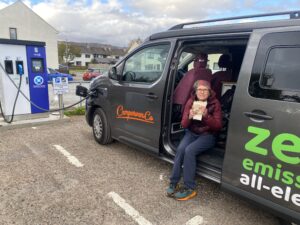
It’s worth noting that in Scotland, there are some useful apps – Charge Place Scotland, Zap-Map, Pod Point and BP Pulse – with information about the location of chargers, charging speed, whether they are working and if they are available (that is, that no one else is using them when you want to). Also, many chargers allow you use of up to 45 minutes only and some allow an hour. Extra minutes can incur a hefty fee.
So, the start of the plan for my north-west adventure was the location of chargers. Fortunately, there are more chargers than I expected there to be.
Starting with a full charge in Inverness, I hoped to do a top up in Ullapool, a town 60 miles north-west of Inverness, then again at Lochinver, 36 miles north of Ullapool, and then again at Ullapool on my way back. If Ullapool was too busy on my return journey, I knew there were other charge points, such as at Dingwall. I hoped to have a final night at Cromarty, on the Black Isle.
With these top up battery boosts, I reckoned I should be able to spend time driving around Assynt and also walking with friends in the mountains.

Campervanning and hiking the Assynt mountains
Assynt is one of my favourite places to spend time outdoors, whether walking, running or cycling. The other-worldly Assynt landscape, edged by a fabulous coastline, is dominated by Inselbergs, which is the geological term to describe the many isolated peaks created from Torridonian Sandstone more than 1000 million years ago.
I hoped to tick off a a few mountain summits with friends, including a route from the small settlement of Inchnadamph to the Munros Convial and Ben More Assynt, plus an outlier Munro Top of Ben More, if we had the time and energy.
On day two the goal was a run-hike of Stac Pollaidh, a smaller mountain with a short but exposed ridge at the summit.

First charge stop: Ullapool
The popular tourist town of Ullapool is situated on the west coast. It is a ferry port that serves the Outer Hebridean islands, among others.
I could see there were several EV charge points on the Zap-Map app. One was busy when I arrived on Friday, early evening, so I headed to the other, which is located in a large car park near Tesco supermarket.
The time limit for charging is 45 minutes (there is a £1 surcharge per minute after 50 minutes). While the battery was charged by an extra 71 miles, I ate a takeaway tea from the Seafood Shack. I also took the opportunity to shop at Tesco.
I then drove to the Inchnadamph area for a van sleepover.

Drive, park and sleep
My friends had booked ahead to stay at a hostel, Inchnadampth Explorer’s Lodge, however, in the EV camper, I could be much more independent.
A camper allows you to be spontaneous. There is no need to book accommodation, nor worry about what the weather will bring, because you can set off at a moment’s notice and in whatever direction you fancy.
A campervan is also self-contained with all the essentials – and many luxuries, too – to provide a home-from-home on wheels.
Smaller vans, such as my own VW T5 and the Toyota Proace Eco REVOLUTION, are easily converted from a vehicle with seats to a place to cook and eat and then to sleep.
After a supermarket shop and stock of the van, you can head off for many days of adventuring, whether you choose to stay in campsites or go off-grid.

Where to sleep in a camper
It’s important that you park and sleep responsibly – and with respect and thought for others nearby.
Many people book into a campsite and there are plenty to choose from in the Highlands. There is also a growing network of more basic “aires”, which are official places for overnight parking in a camper or motorhome but with more basic facilities compared to most campsites. There is normally a small charge for use of aires.
To find a list of aires see a number of websites:
For more ad-hoc overnight lay-by parking – some call this wild campervanning – the laws vary across the UK. There’s no specific legislation that stops you sleeping in these spots overnight, however, if the local authority forbids it, the police may come and move you on.
I do park off-grid and make use of aires where I can, as well as some discreet lay-bys and car parks. But I won’t tell you where I park, just like I won’t tell you where I wild camp. I think this is all part of the adventure of campervanning and camping in Scotland.
My aim when parking overnight in a camper is to make sure I’m nowhere near people’s homes. I aim to park off the main roads and I don’t park on verges or where I might draw attention to myself. I also prefer, if I can, to park after dark and leave as early as I can. I always take away all rubbish etc.
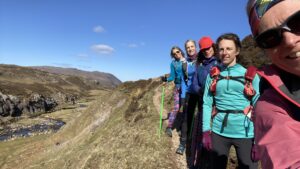
Park, sleep – and then hike
A campervan allows me to sleep close, or next, to, my chosen walking route. I like to wake up, eat breakfast in the van and then easily and quickly set off for my day’s hike.
At the end of the walk, it’s great to be able to change clothes, eat a snack and have a cold drink from the fridge, or make a cup of tea. I have become very used to using my van as a convenient changing and cooking place.

A hike of Conival and Ben More Assnyt
The Munros include all 282 Scottish mountains with a height of at least 3000ft/914m. Conival and Ben More Assnyt offer a great day out for walkers. The 12-mile return route was a filled with incredible views across the superb Assynt landscape and further afield to the coast and many islands.
I was joined by four friends and as we followed a well-trodden path, we chatted and laughed. A long day in the mountains is always so uplifting and rewarding when you are with good friends.
We headed first to Conival summit at 987m, then Ben More Assynt at 998m. From Ben More Assynt, a southern outlier summit could be seen. This peak is classified as a Munro Top, which I was keen to bag.
My friends agreed to accompany me to the 960m top and while it added another 2km to the route, plus a short but tricky scramble, we were all happy to make the most of the fine weather.
To return to the campervan, the route took us back over the Munro summits of Ben More Assynt and Conival again. This meant we had walked to a total of five summits with some elevation gain of 1455m.
Back at the van, I relaxed for a while, enjoying a cold drink from the fridge and changing into clean clothes. I also discussed plans for the next day’s mountain with my friends before heading off to find my own quiet overnight spot.
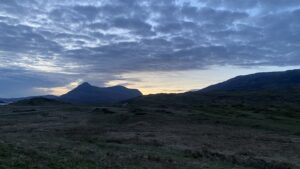
A van dinner – and a sunset
The Toyota Proace Eco REVOLUTION proved to be a lovely place to spend another night. I drove to a quiet place close to the sea, parked, switched off the engine and headed into the back of the van.
The van is quick to set up for cooking and eating and I especially liked the pop-up top. My own van does’t have a pop-up, which means I can’t stand up inside. It was a joy to be able to walk around the van without hitting my head.
My evening meal was a home-made quiche, that I re-heated in the van’s microwave, plus a salad. After washing up plates and cutlery, I enjoyed a herbal tea before pouring a deliciously chilled glass of wine.
As I sipped the wine, the the sun set over the sea. There are few places to beat a west coast Scotland sunset, especially when you are off the beaten track and you feel like you are enjoying your own private viewing.
The van’s leisure battery offers plenty of useful power. I was able to fully recharge my phone and sports watch and I found I had enough access to 4g to be able to check the internet for the next day’s weather. I
The camper’s bed is easy to pull out to horizontal and I climbed under my duvet feeling a wave of tiredness. Sleep came easily and I awoke early but well rested.
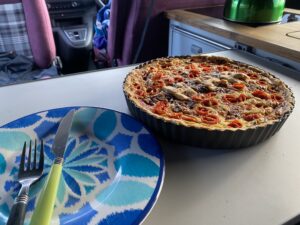
Breakfast and a charge up at Lochinver
The coastal village of Lochinver – famous for Lochinver pies from the Lochinver Larder! – provided the ideal location for a van breakfast, while I gave the Toyota Proace another battery booster.
Again, there was a 45-minute charge limit but this time the charge provided an extra 100 miles. It was the same speed of charger as Ullapool, but for some reason I got an extra 30 miles of charge in the same time. This gave me the confidence to know I would be able to drive to Stac Pollaidh and then back to Ullapool and on the Black Isle.

Stac Pollaidh ridge and summit
The drive from Lochinver to Stac Pollaidh led me along a narrow and winding tarmac road that undulated through the remote and ancient landscape. I was grateful for the charge boost at Lochinver, although I needn’t have worried in the end because I had more than enough mileage in the battery to reach the car park and then return south to Ullapool.
Most of the time, the camper had plenty of power in eco mode but when I needed a bit of a boost uphill, I simply switched up the modes.
Stac Pollaidh is an iconic mountain that provides a short but airy hike. The true summit at 612m elevation and to the east, is reached on an exposed ridge, although many people still enjoy the rewards of spectacular views from the lower, but easier to reach, western summit.

More charging at Ullapool
It would have been possible to return to Inverness without another charge, but I was keen to extend my long weekend trip with a visit to the coastal village of Cromarty on the Black Isle peninsula. There were alternative charge points in locations, such as the new Corrieshalloch Gorge Visitor Centre, Strathpeffer and Dingwall, but Ullapool offered a convenient place for a cafe and a look around a bookshop. It struck me that while journeying in the electric camper there is a requirement to stop for battery charges, however you also make more time to visit villages and towns that you might ordinarily drive straight through.
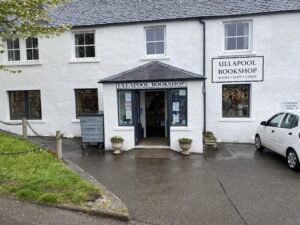
Cromarty views and another walk
Cromarty is located on the northern tip of the Black Isle and on the southern shore of the mouth of the Cromarty Firth. The attractive village grew up around the fishing industry in the 18th century.There are some lovely places to eat and plenty of historical interest, such as Cromarty Courthouse Museum and a birthplace cottage and museum that reveals the life and work of famous Scottish geologist Hugh Miller.
The views from Cromarty are unusual. The Cromarty Firth is home to many oil rigs. The rigs aren’t drilling there, but they are either in the process of being decommissioned or they are being kept in a sleeping state, ready to be moved back out to the North Sea should they be required.
Some people find the views of the rigs incongruous against the picturesque coast and hills but I like the juxtaposition of industry and nature.
I parked along the coast in a lovely peaceful spot for my third night in the electric camper. I enjoyed a very different view compared to the west coast, of sea and rigs. Overnight the wind picked up and when I awoke it was raining and the sea was rough with white horses. It mattered not though because I was warm and cosy inside the van looking outside. A short coastal walk to visit the fascinating Cromarty Cemetery rounded off my “electric adventure”.
I returned to Inverness for another charge of the Toyota Proace camper. After days of driving the electric vehicle, I realised I was feeling a lot more relaxed than when I started out…

Final thoughts on electric camper travelling
I confess that before I set off for the electric camper adventure, I was anxious about driving a fully electric campervan in the Highlands of Scotland. I wasn’t familiar with EV charging, and I worried the chargers would not be available, or I would run out of charge between each point.
The journey required some planning to ensure there were useful charge points. I was also much more aware of mileage “used” as I drove. But once I’d set off, it all worked out very well.
Overall, I was very impressed with how well the e-camper drives and the facilities of the Toyota Proace Eco REVOLUTION vehicle. It’s great to also have the versatility of being able to use the vehicle as a seven-seater or as a van.
I think that the infrastructure of EV charge points needs to grow to make it easier and slicker for people to charge vehicles. Plus, there is a cost factor. I was surprised that the electric charge costs were not cheaper.

There are, of course, plenty of environmental debates and arguments to be had about buying a brand-new vehicle and the benefits, or not, of electric transportation. I’ll leave this for a discussion over a beer or two with my friends – and I have no doubt others will be doing the same. There are plenty of articles on-line on the topic.
To conclude, if you are in the market for a new vehicle and you hope to buy electric, then having transport that is useful as a large car, a van and a camper might well appeal. The Toyota Proace Eco REVOLUTION does all of this, and I greatly enjoyed the experience of taking it for an adventure for a few nights.
You May also be interested in: The die is cast: petrol and diesel engines are dying. The electric age is inevitable, by Ben Lan, Founder & CTO of Zapmap, in The Guardian
